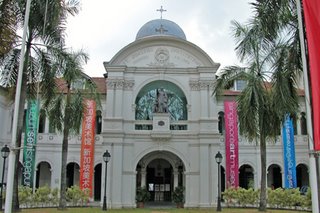
On Sunday we went to the Asian Civilization Museum on Armenian Street, but when we got there, it was closed for renovation until 2008. My guidebook was printed prior to the beginning of this year, which was when the Museum closed its door for a couple of years. Further reading revealed that this museum would reopen as a full-fledged Peranakan Museum (Peranakan is a term used to describe the assimilative Chinese culture to the Indigenous one.)
My friend and I decided to walk a few blocks to another museum, the Singapore Art Museum. The Museum celebrated the native sons and daughters, as well as those from neighboring South-East Asian nations. It is housed in what used to be the Catholic all-boys school, the St. Joseph's Institution. The current museum opened in 1996.
As I mentioned before, going to Singapore back in the 70s and 80s was synonymous with going shopping, not visiting galleries and museums. It was not for the lack of want, but back then, the focus of this city-state was its economy, and the government probably ushered foreigners from the airport right onto Orchard Road. Although there were educational outlets cum natural showcases, such as the Bird Park and Botanical Gardens, or entertainment for the masses such as the Sentosa Island, museums were not aggressively marketed. The Singapore Art Museum, for example, only opened in 1996. Like in Indonesia, the arts and the artists have always existed, but never appreciated and recognized the way they are now.
This Singapore Art Museum is quite young, which is apparent from its collection, but its 13 galleries with over 4000 works of art have made the museum the biggest collector of South-East Asian contemporary art in the region. One special exhibition, titled the Beneath the Pavement: Discovering the City, had a twist in the title. An image conjured up from such title of an exhibition was of the infra-structure of a city, or perhaps the sewage system, but in actuality, it referred to the basic element of a city: its people.
The layout of the temporary exhibitions could have been better planned and executed; the way some exhibit was arranged looked like an afterthought. The former open-air corridors of the building are now glassed in, but there does not seem to be any thought about shielding the work of art from the direct exposure to the sun.
***
On Monday we visited the "other" Asian Civilization Museum at the Empress Place. The one we visited on Sunday (the same one that was closed for the renovation) was Phase I. This museum, Phase II, is housed in the Empress Place (named after Queen Victoria, Empress of India) and has opened since February of 2003. More than a hundred of grade school to junior-year students happened to choose the same day to visit the museum. As a result, there was no studying any relics without hearing within an earshot some giggles or gossiping nearby. I limited my visits to the South-East Asia and China departments. The guidebook mentioned the conspicuous absence of Japan. I suppose in keeping with the non-confrontational attitude that is Singapore, it is better to keep potentially controversial and debate-arousing presence of Japan off the museum floor. Somebody has done a real life Photoshop!
Click here for more pictures.